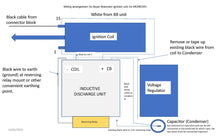Our new inductive discharge ignition system comes ready to fit with Messerschmitt specific wiring that is fully terminated so no cutting or joining of cables is required. By eliminating voltage drop and improving the spark, idle speed can be significantly reduced thus aiding gear changing - especially first to second. Built in timing light makes for easy set up. Fits on side of reversing relay and retained with tie provided. Black box cover can be re-fitted on completion. If your cam is worn or the contact breaker heel is worn, consider buying our full electronic system. Contact breaker condition is not important because it becomes a signal switch instead of switching the high coil current.
In the Messerschmitt, current flows from the positive terminal of the battery into the Black Box then to the ignition switch and on to the positive terminal of the ignition coil (numbered 15). The current returns to the battery through the negative terminal of the ignition coil (numbered 1) on through the contact breaker to the motor ground (earth) in the contact breaker housing, and to the negative terminal of the battery. While current is flowing in the primary circuit a magnetic field builds up in the ignition coil. This current cannot be measured with a conventional meter but if viewed on an oscilloscope, we would see 8 to 10 amps for a period of 1 millisecond (mS). This is the key to understanding why alternative ignition systems offer a smoother idling speed.
Due to the inductance of the ignition coil it takes some time (typically 1-6 mS) for the primary current to reach its nominal value. When the primary current flow is interrupted, the magnetic field collapses rapidly in about 20 microseconds (µS) and a high voltage is induced in the primary winding (CEMF Counter electro motive Force). This voltage is transformed to a very high voltage in the secondary winding - for a Messerschmitt, this is 8,000 to 10,000 volts. The voltage will only build until the break down voltage of the spark gap is reached - the firing voltage of the spark plug.
A key fact is that the voltage at the coil is nominally 12 volts BUT the Messerschmitt has many joints and connections between the battery and the coil and with other devices running at idle speed (brake lights, flasher, lights, etc), the voltage can be less that 11 volts. At running speed, the voltage rises to 13.5 volts and the spark voltage is directly proportional to the coil input voltage so idle speed gives a weaker spark. Electronic ignition reduces the adverse effects of the lower voltage thus improving operation.






